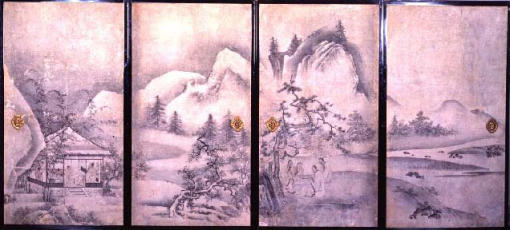The Four Gentlemanly Accomplishments
Editor's Note: This resource can be used in conjunction with the lesson Awakenings: Zen Figure Painting in Medieval Japan.
The Medieval Period in Japan (12th–16th century) was a time of unprecedented closeness in the relationship between China and Japan. Ideas were exchanged freely and travel between nations was frequent. Furthermore, Japan looked to China at this time as a cultural model and readily absorbed their artistic, religious and intellectual traditions.
Among the ideas transmitted from China and cultivated in Japan during this period was the concept of the gentlemanly scholar: literate in Chinese and skilled in the refined arts of calligraphy, painting, chess, and playing the qin (a stringed instrument, pronounced “kin”). These skills are known as the "Four Accomplishments," two of which are represented in the panels shown here. The group of men to the right is playing chess, while a gentleman in the building to the left is viewing a painting (demonstrating an understanding of calligraphy and painting).
Related to this phenomenon, artwork was abundantly imported from China to Japan during this period and thus influenced Japanese aesthetics. One example of this aesthetic and artistic cultural exchange can clearly be seen in these panels. The paintings follow the contemporary Chinese schema of emphasis on detailed landscape, including a clear fore-, middle- and background separated by an indistinct negative space.(1)
-------------------
1 Barnet, Sylvan & Burto, William. Zen Ink Paintings. Tokyo: Kodansha International, Ltd., 1982, p.68.
The Four Gentlemanly Accomplishments (2 of 4 sets of doors). Oguri Sokei (act. late 15th–early 16th c.). Japanese, Muromachi period (1392–1573), 16th c. Eight sliding-door panels (in two sets of four), ink and light colors on paper; 171.0 x 117.5 cm (each, first set); 169.5 x 91.2 cm (each, second set). Kyoto National Museum.
Important Cultural Property. Photo: Kanai Morio; courtesy of Kyoto National Museum.


